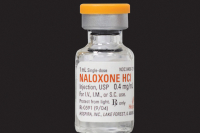Blood donors show loyalty to Red Cross
 The new contract Mission Health signed with The Blood Connection for blood products will affect the American Red Cross’ collections in Western North Carolina, but Red Cross employees and volunteers hope donors will remain loyal to their cause.
The new contract Mission Health signed with The Blood Connection for blood products will affect the American Red Cross’ collections in Western North Carolina, but Red Cross employees and volunteers hope donors will remain loyal to their cause.
Blood Connection, a regional nonprofit blood bank in Piedmont, South Carolina, will now be setting up blood drives at Mission hospitals in the region, forcing Red Cross to find new sponsors willing to accommodate its mobile drives.
Angie Williams, who has been a Red Cross team supervisor for 12 years, said she is afraid donors won’t know the difference in organizations.
“Unfortunately, I think it will hurt us,” she said. “I think donors don’t know exactly who Blood Connection is — they think we’re all tied in together.”
Her job is to supervise up to 11 mobile blood drives on any given day and to meet daily blood donation quotas. She makes sure her staff members and volunteers have what they need to make the blood drive a smooth process for donors.
Williams said donations overall are on the rise, even though holidays and summer months are a tough time to get donors to come out and give because so many people go out of town.
Related Items
She said she was afraid Mission’s switch to Blood Connection might reduce Red Cross donations. Unlike Blood Connection, she said, Red Cross couldn’t offer free gifts as incentive to recruit new and younger donors.
Mission said another plus with contracting with The Blood Connection was that all the blood being supplied would stay local. But long-time blood donors don’t seem to care whether their donation helps someone in Western North Carolina or someone on the other side of the country.
Haywood County resident David Willett has donated about 60 pints of blood in his lifetime. He returns to a Red Cross blood drive about every 60 days to donate, and he does it just for the sake of helping someone else in need.
“My son had to have two units a few years back and someone donated on his behalf, so I’ve just continued to do it for someone else,” he said.
He wasn’t aware of Mission’s change in suppliers but said it probably wouldn’t change his donation habits. He’d like to see his donation help someone locally first, but if his blood is needed elsewhere, that’s OK by him.
“But I will likely stay with Red Cross. They helped me, not just with blood donation, but when I went through the floods in 2004 in this county, they were there to help me in a number of different ways,” he said. “I lost the house and 90 percent of what I owned — loyalty means something.”
Williams said she rests easy knowing blood donated to Red Cross helps people locally and sends blood, plasma and platelets to those in need throughout the country.
“If you have a niece in Kansas City and she had a baby that needed a certain component of blood that no one else in Kansas had – we’re going to find that component,” she said. “If there is a disaster somewhere and roofs are falling in and people are hurt and need blood, we would send it. That’s where I’d want my donation to go.”
Williams said she hopes the Red Cross’ customer service and volunteer base will speak for itself during this transition. She’s had several donors tell her that they have given to both organizations and decided to stick with Red Cross.
“One lady said the last couple times at Blood Connection it was a bad experience,” she said. “They get the job done but we have the customer service and we take care of our donors.”
Susan Sikorya, a Red Cross collection specialist, was working at a recent blood drive organized locally at Long’s Chapel United Methodist Church in Clyde. As she told her story, she was collecting blood from Rick Silveira of Waynesville — someone who donates as often as he can.
Not only has Sikorya worked for Red Cross for nearly 10 years, she has been on the receiving end of Red Cross’ mission.
“I’ve needed blood twice in my life — once for emergency surgery when I needed plasma and then eight months later I had hernia surgery and needed blood,” she said. “I know my job has purpose.”
Silveira said he would continue to give blood through the Red Cross even though Mission Hospital is now contracting with The Blood Connection.
Carol Honeycutt, blood drive coordinator for Long’s Chapel, said more than 80 people had signed up that day to give blood despite the wintery mix weather outside. Walk-ins are also welcome. She said she wasn’t worried about losing any loyal donors to Blood Connection. Her challenge, and Red Cross’ challenge, has always been getting younger people to start donating.
“We have people who have given for years, but we’re losing some and we need to get some younger people started,” she said.
In her experience, she knows that once people in the 18-to-30 age group donate for the first time, they will keep coming back.
“Once they donate, they realize it isn’t as bad as they think,” she added.
Cost of blood
While Blood Connection is only a blood bank, blood collection is only a portion of Red Cross’ overall mission, which includes disaster relief. A broader mission and a national network result in larger overhead costs, one reason why Red Cross may charge higher fees than Blood Connection.
“The Red Cross, like other not-for-profit blood centers, charges a cost-recovery fee to hospitals and transfusion centers for the costs associated with providing blood to patients,” said Natividad Lewis, external communications manager for Red Cross in Charlotte. “The Red Cross does not charge blood recipients for the blood itself. However, a hospital or transfusion center may pass those costs on to the individual patients who use blood products during treatment.”
She said the Red Cross cost recovery fees are determined by both market-level and hospital-level factors. The fees include costs associated with testing each unit of blood, recruitment and screening of donors, blood bags and equipment used to collect blood, the actual collection and processing of blood products, storing blood products and distributing blood components to where they’re needed most.
“Specific cost-recovery fees are confidential per our hospital agreements,” she added.
According to Red Cross’ 2014 annual report, the demand for blood services has decreased because medical treatment advancements have minimized the need for transfusions. Despite that trend, donations are still critical since only a fraction of the people eligible to give blood actually do.
Red Cross must collect about 15,000 units every day to meet the needs of accident victims, cancer patients, children with blood disorders and others. Lewis said the Carolinas Blood Services Region, which includes North Carolina, Tennessee, South Carolina and Georgia, had nearly 203,000 donors in fiscal year 2014. She said a strong donor base allows Red Cross to be able to supply hospitals with rare blood types, plasma and platelets.
Lewis said Mission’s new contract with Blood Connection would not change Red Cross’ goal to supply blood to anyone who needs it.
“The Red Cross values our relationship with Mission Health, and we will continue to be ready to respond to requests for blood products,” she said. “As a national network, the Red Cross has a unique responsibility to help ensure blood is available for patients whenever and wherever it is needed. We remain committed to all the communities we serve — whether by providing lifesaving blood products or preventing, preparing and responding to local emergencies.”
Upcoming Red Cross blood drives
• 2:30-7 p.m. Feb. 19 at American Legion, 171 Legion Drive, Waynesville.
• 12:30-5 p.m. Feb. 19 at Haywood Community College, 185 Freelander Dr., Clyde.
• 1:30-5:30 p.m. Feb. 20 at North Canton Elementary, 60 Thompson St., Canton.
• 1-5:30 p.m. Feb. 27 at Evergreen Packaging, 34 Park St., Canton.
Donation facts
• Donors can give blood every 56 days
• Donors can give platelets every 7 days
• 1 pint of blood can save 3 lives
• Every 2 seconds, someone needs a blood transfusion
• 5 million patients in the U.S. need blood every year
• Less than 38 percent of the population is eligible to give blood
• Platelets, critical for cancer patients, have a five-day shelf life
• Only 7 percent of the U.S. population has the universal blood type of O negative
Cycle of donated blood
1. Registration — Give health history and get a brief physical
2. Donation — Once eligibility is established, the blood is drawn, taking about 10 minutes
3. Documentation — Each unit of blood taken is given a number, which is scanned into a computer and can be tracked.
4. Separation — Blood can be processed into red cells, platelets and plasma. Spinning them through a centrifuge separates the components.
5. Testing — Blood type is determined and then the blood is tested for several transfusion-transmitted infectious diseases.
6. Quality assurances — If any blood tests positive for disease, the donor is notified and the blood destroyed.
7. Storage — Blood is labeled and sorted by type.
8. Shipping — Blood is shipped to hospitals across the country.
2014 statistics
• 5.3 million units of blood collected
• 3.1 million volunteer blood donors
• 8 million transfusable blood products distributed
• 2,600 hospitals and transfusion centers
Source: www.redcrossblood.org
American Red Cross history
• Clara Barton established the American Red Cross in 1881 after being inspired by the Red Cross networks in Europe.
• The Red Cross received ratification of the Geneva Convention to protect the war-injured in 1882.
• Red Cross received its first congressional charter in 1900. Its most recent version of the charter was adopted in May 2007.
• At the military’s request during World War II, the Red Cross initiated a national blood program that collected 13.3 million pints of blood for use by the armed forces.
• The first civilian blood program was introduced after WWII and now supplies 40 percent of blood and blood products in the U.S.
• The Red Cross engineered a modernization of its blood service operations in the 1990s to improve the safety of blood products through new testing for HIV, Hepatitis B and C and other viruses.
• The Red Cross holds more than 200,000 blood drives every year and provides blood for patients in about 2,700 hospitals across the U.S.









